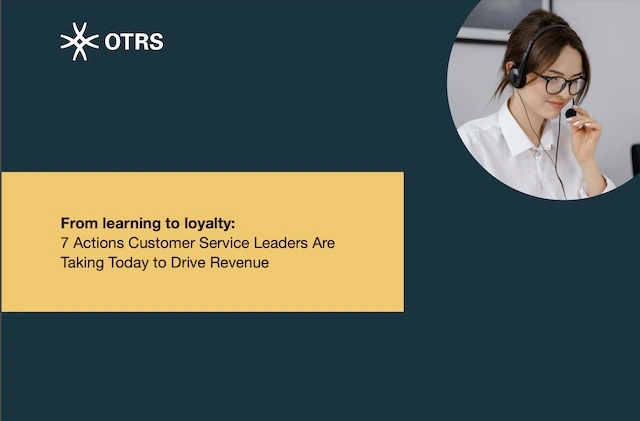

Defining Contact Centers
A contact center is an overarching term for the organization of people, processes and technology that support customers. People who work as part of the contact center are called agents. Agents are sometimes called call center agents or customer service agents.
Customers use a contact center in many ways. They may seek information about products and services, or they may want answers about their account status. They may be reporting broken items, or they may be ordering something new.
Whatever request the customer has, agents are there to offer help and find solutions.
Contact centers also work in support of the business. Modern contact centers play a significant role in building customer loyalty and keeping customers engaged with the business’ products or services. Loyal engaged customers continue working with the company longer, make more referrals and often purchase additional products or services. So, the contact center plays a key role in driving revenue.
The Role of Contact Centers
Contact centers play an essential role in businesses of all types. They help ensure customer expectations are met and increase sales in a variety of different ways:
- Improved customer satisfaction (CSAT) scores
- Better net promoter scores (NPS)
- Increased referrals
- Opportunities for up-selling and cross-selling
- Better product engagement
- Increased data about customer needs and pain points
- Lower churn rates
And these hold true across all industries. Consider some of the ways in which you’ve interacted with contact centers in these common industries.
- Healthcare. Supports patients as they navigate the complexities of health care services, medication management, appointment setting or billing.
- Retail. Helps customers select the right products, handles complaints, processes returns, makes additional product recommendations or offers information about shipping status.
- Aviation. Provides customers with alternative schedules, tickets, information about travel restrictions or flight policies and procedures.
- Education. Helps students schedule classes, pay bills, get support from staff, obtain equipment or see their grades.
- ISPs. Enables technical support agents to resolve computer problems, manage purchasing requests, oversee contacts and provide technical guidance from afar.
Regardless of the type of business, customers will need help and their data must be organized. The customer experience is positive when they get the right help from the contact center. This leads to revenue growth for the business.
Types of Contact Center Communication
Agent skills and business workflows will determine whether inbound and outbound calls are handled by the contact center.
Inbound calls
Inbound calls are calls that are started by the customer. Examples of inbound calls are making a purchase, requesting technical support or checking on a repair request.
Outbound calls
In contrast, when the agent begins the contact, it is referred to as an outbound call.
Outbound calls can refer to a variety of activities, such as up-selling efforts, scheduling appointments, or sales cold calling. They can also be used for routine customer check-ins.
Businesses often use a hybrid approach to inbound and outbound calls. This means agents in one contact center handle both types of calls.
Omnichannel vs multichannel communication
Omnichannel and multichannel solutions both support multiple channels.
Customers can connect with the contact center through traditional and digital channels, such as
- in person
- phone
- social media
- messaging tools
- online forms
- chats
- SMS
The difference between the two contact center types is in how communication is coordinated.
With multichannel communication, communication cannot switch from one channel to another. So, for instance, a conversation that is begun in email stays in email.
Omnichannel communication is different in that it breaks down communication silos. Communication about a subject may begin on one channel. It can then be continued without disruption on another channel.
For instance: A customer sends a complaint via one of the company’s social media channels. The call center team receives this complaint as a ticket in the ticketing system, as the social media account is connected to the ticketing system. This allows the call center team to send the response from the ticket to the social media channel and offer further communication to resolve the issue via email.
Contact Center Technologies
Agents use a wide range of technologies and tools in order to connect with and offer help to customers. Some contact center tools include:
- IVR systems are interactive voice response systems. They allow customers to get information from the contact center without talking to an agent.
An example is when you call a phone number to check your account balance. You enter your account number. The interactive voice response (IVR) system will then provide information tailored to you.
- As mentioned, communication channels are plentiful. Customers contact the support desk in many ways, such as phone, Whats App, Messenger, Twitter, chatbots, and email.
- CRM stands for customer relationship management. Customer relationship management software tracks the complete customer experience for each individual customer
- Workforce management tools support shift scheduling and resource optimization.
- Customer service software tracks open customer support requests and structures the related customer communication and knowledge. It ensures a more efficient and consistent customer experience. A ticketing system often provides the platform for a customer service software.
- Remote access software allows access to remote computers by technical support agents that are not onsite.
Choosing the right tools depends on your business model. Examine your existing workflows to see where improvements can be made and which technology options are worth the investment.
Contact Center Software Hosting Options
There are a few different types of contact centers to select from. Your choices depend on the business model, staffing capabilities, and the type of customer experience desired. Each has unique benefits and considerations.
Businesses must decide whether to use cloud-based or on-premise software for their contact center. This decision should come first when selecting software.
Cloud-based contact centers
Cloud-based contact centers are mean that communication and data are routed through internet servers. This allows both customers and agents to access services from any location. This means that help is always available to customers.
Cloud-based contact center solutions also offer several benefits for the business. First, the solutions are scalable, so they can grow as the business grows. Second, they are typically easier to deploy, so the contact center can be efficient more quickly. Third, backups and recordings are possible, so no data is lost.
On-premise contact centers
On-premise contact centers are becoming less appealing because of the more extensive management involved. To use on-premise contact senter solutions, additional hardware must be purchased and IT staff must offer support. Additional support from the seller can also cause the business to incur extra expenses.
There are, however, situations when an on-premise contact center may be required. In some industries, legal regulations require data to be managed and monitored on-site. Examples include healthcare and defense contracting. In these cases, an on-premise solution can be the best choice.
Best Practices for Contact Centers
Operating a contact center requires creativity, a focus on data and a strong understanding of one’s customers. Yet, there are many best practices that leaders can use to improve contact center service.
- Develop knowledge management. Agents must know a wide range of information about the business. It is ideal if people can recall the information they need.
However, usually they must refer to outside sources to find an answer. Develop systems that structure information so that agents and customers can quickly get the necessary answers.
- Place value on face time. While wait times and close rates are important in terms of efficiency, remember that agents add value because they are human. So, appreciate the time spent when customers interact with agents.
- Invest in technology. Every business is unique, with different needs. The above list is a sample of what can be used to support the contact center. Consider ways in which technology can better support your people, processes and the customer experience.
- Leverage reporting. Of course, you’ll use it to measure efficiency. You can also use it to find your top performers and reward them or steer them into mentoring roles. Conversely, it can be helpful for identifying agents who need to develop new skills.
- Focus on agent skill building. Figure out what topics agents are most interested in and offer opportunities for growth in those areas.
- Simplify the hand-over of work. Whether its planned vacation or an unexpected sick day, agents will have days out of the office. Customers don’t care: They want help when they need it.
Be sure to have task handover workflows and technology in place. This makes it easier to pass along a task and its background information from one agent to the next.
- Structure and use data. As phone calls come in, contact center agents are obtaining piles of data about customers. Establish workflows to ensure this information is well captured and put to use by the sales and product teams.
Future of Contact Centers
As technology continues to evolve, so too will the expectations of customers. Therefore, contact centers will also need to change to meet these needs. We can see this already starting to happen in many ways.
- Artificial intelligence (AI) is already being used to improve the quality of responses given by chatbots. It is also helping to predict and analyze issues across the customer base.
- Virtual reality (VR) is helping customers gain “real life” experiences with products, people and physical environments in real time.
- Business process automation is rapidly removing the strain from administrative and redundant tasks. As this improves, agents gain valuable face-time with customers that further increases the satisfaction customers feel.
- The promise of omni-channel communication is steadily becoming a reality. Customer service software can aggregate communication from multiple channels. This creates a single communication stream, making it easier to move between channels.
Conclusion:
Business sustainability requires a focus on lasting customer relationships.
This can only be done when customers stay happy about and engaged with the business’ products or service. Thus, the contact center plays a key business role.
Investments should be made to ensure the success of agents. These investments should include technology, training and benefits. This will ensure the long-term growth and position of the business.
Categories
- About OTRS Group (21)
- Automation (3)
- Corporate Security (26)
- Customer Service (30)
- Developing a Corporate Culture (12)
- Digital Transformation (54)
- General (86)
- ITSM (36)
- Leadership (22)
- OTRS in Action (8)
- Processes (5)
- Using OTRS (15)

